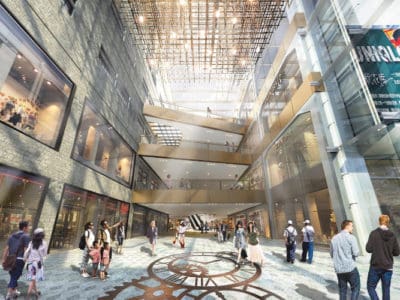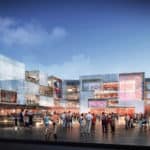
Qin Pang, head of Benoy’s Shanghai studio
Global design firm Benoy has created some of China’s most distinctive architectural landmarks since the UK-based studio first opened its doors in Shanghai in 2008. Today, as the firm celebrates the ten-year anniversary of its first office in mainland China, Benoy’s leaders in Shanghai draw on their experience designing properties from retail malls to sprawling urban masterplans to glean insights on the emerging trends and opportunities in China’s booming architecture market.
Mingtiandi spoke with Qin Pang, head of Benoy’s growing Shanghai studio of almost 80 people, and Simon Wong, director in Shanghai, to explore the firm’s role in shaping China’s cities and what lies ahead as mainland developers increasingly turn their attention to transit oriented development, community spaces, and culturally focussed projects.
Mingtiandi: From an initial focus on retail projects in China, Benoy has diversified its business scope to include urban redevelopment projects, mixed-use complexes, an art centre in Hangzhou and an R&D park in Shanghai. What is driving this shift in emphasis?
Qin Pang: Benoy has always been known for its heritage in retail, which at its heart is understanding how to design places which engage and excite people alongside bringing commercial viability to our clients. As the market continues to be more competitive, developers and owners are seeing the value and importance in “destination creation” and the balance of creative design alongside long-term viability of their developments – so we are seeing our skill set in demand across other sectors.
That being said, our teams have always had a broad range of experience across different sectors and services, so we bring a wide-ranging capability to our clients.
We are also fortunate to have built long-term relationships with our clients – in the case of the Hangzhou Art Center and the Yuqiao Innovation Park which you have mentioned, we had been working with these clients previously and they could see how our design approach could be effective within these projects.

Simon Wong of Benoy’s Shanghai studio
Mingtiandi: How has the experience of working with mainland developers changed (if at all) since Benoy was commissioned to design Phase 3 of China World Mall?
Simon Wong: The market in China has continually evolved over the last decade, becoming much more discerning and sophisticated. We are fortunate to be working with clients who are extremely well travelled and well versed on the latest developments across the world. China is dynamic, fast-paced and inventive; it’s a market where we have been able to showcase some of our most creative work, in my opinion, as our clients are willing to push the boundaries with us.
Mingtiandi: Benoy has been designing for 71 years. What capacities has Benoy been able to develop through its decade of experience in China that might have been hard to develop in smaller or slower growing markets?
Qin Pang: The sector that stands out most to me is our work on transit oriented developments. China is a fast-paced market and its sheer growth and investment in infrastructure has given us invaluable experience with interfacing with large-scale, mixed-use transit oriented destinations. As this model makes its way back to the West and other regions, we are exporting this experience from our Shanghai and Asia teams to new parts of the world.
More recently, the appetite and opportunity from developers to work on historic conversion and restoration projects – and celebrate the history and existing buildings on some very important sites – has also been growing, which is exciting for the next generation of Benoy projects.
Mingtiandi: What role can a design firm such as Benoy play as China continues on its development trajectory in the next ten years?
Qin Pang: After the era of rapid development of the China real estate market, we are seeing a change in the trajectory with the market slowing and focusing on more delicate, personalised and culturally identified projects and developments. As an architect, I was personally delighted to see this change and have new opportunities for our work.
The role Benoy plays in the overall trajectory of the country is difficult to answer. The market is always changing and is perhaps more demanding of good design than ever before. The opportunities we are working on and have been given across China tell me that our skillset is in demand and we are producing designs which are resonating in the market and helping to shape the next generation.
Mingtiandi: What are the trends in China’s design industry and can you point to specific Benoy projects that are breaking new ground?

Benoy’s Nanjing Zhongye MCC World, a waterfront redevelopment project, is designed to serve as a new community hub
Simon Wong: We are currently working on an exciting portfolio of retail-led projects which each have their own identity and uniqueness and have been breaking new ground in bringing the retail experience to another level.
The trend towards the convergence of the physical and digital retailing spaces is very interesting for us in how this is informing our design process – how we design spaces to adapt to this.
We are working closely with the developers and retailers to look at “blurring the boundaries” between the public and retailers’ spaces as well as the indoor and outdoor areas. We are seeing a rise in immersive and interactive spaces where the consumer can digitally connect to retailers and the malls. Obviously, the role of cultural and entertainment experiences and how these are shaping future destinations is big trend which is shaping the sector.
Mingtiandi: Some of Benoy’s work, such as Nanjing Zhongye MCC World, has focussed on revitalising heritage sites. Is there a greater appreciation for historic preservation in China, compared to when Benoy started out?
Qin Pang: For me, it signifies how the market is maturing and becoming more conscious of preserving and maintaining the historic built environment of our cities. Previously, we had seen more of this work for regeneration and renovation in mature markets like Europe. For Benoy, we are able to drawn on our international skillset, bringing expertise from historic projects in the West into China and blending this with our local insight to bring new life to these historic sites.
Mingtiandi: After doing early work with international developers in Shanghai and Beijing, Benoy has now taken on projects such as the INCITY MEGA waterfront development in Wenzhou and the Shandong Greenland Grand retail development in Jinan. Is the market for design changing in China?
Qin Pang: The “sharing” concept is definitely gaining traction – whether it be co-working or co-living, we are seeing more demand for this type of thinking in our current projects. Enhancing the public realm and ensuring there are spaces for the community is also high on the agenda with developers. Of course, the advancement and influence of technology is shaping our design process with virtual reality and augmented reality, for example.
Mingtiandi: Benoy is also active in designing masterplans such as a new business district in Shanghai’s Qiantan. There are few markets in the world that provide so many opportunities to do planning on that scale. What is the demand for large-scale urban redevelopment projects in China and is Benoy targetting further opportunities in this space?
Qin Pang: We are still seeing demand in this sector across China. As markets go through different maturity levels, different opportunities arise. We are seeing a shift towards larger masterplans which are focusing on regenerating former industrial districts, brownfield land, into new destinations for the community, for example.
Mingtiandi: What is the role of an international architecture firm as Chinese architects and homegrown studios raise their profiles?
Simon Wong: The market is definitely becoming more competitive with more design firms raising their profiles in the market. For Benoy, while we are a British and international firm, we also are firmly in touch with the local market conditions and have an incredible mix of talented designers including both international and local architects. Whether you are an international or local firm, your success relies on your ability as designers – and given our success over the last decade, and looking at our portfolio going into the next, we are confident Benoy still has a huge role to play in the Chinese market.
Below are a few of Benoy’s projects currently in the works in cities across eastern China:
- Yuqiao Innovation Center (Shanghai)
- INCITY MEGA (Wenzhou)
- Nanjing Zhongye MCC World (Nanjing)
- Nanjing Zhongye MCC World (Nanjing)
- Hangzhou Canal Art Center (Hangzhou)
- Hangzhou Canal Art Center (Hangzhou)
This sponsored feature was contributed by Benoy.






Leave a Reply